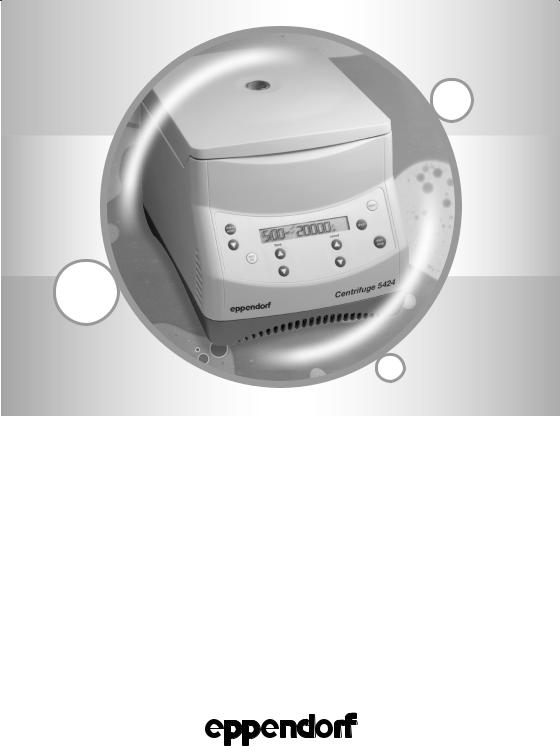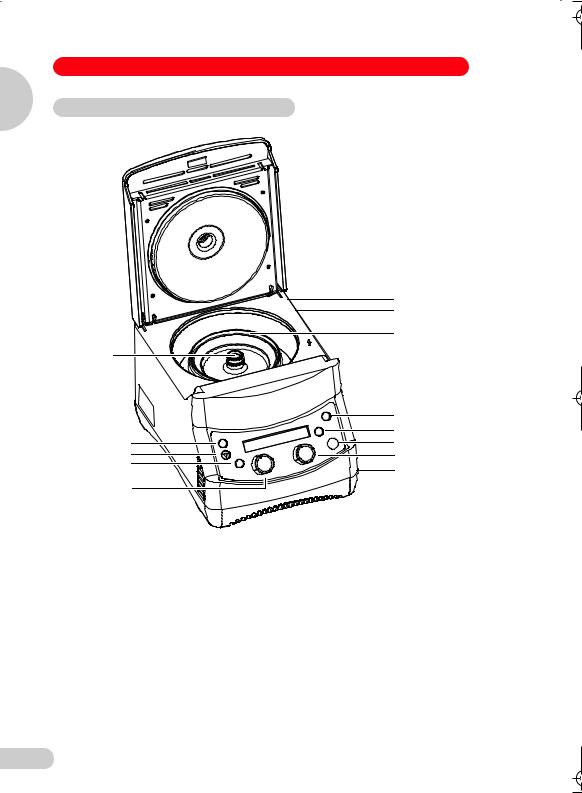Eppendorf 5424 User manual

Centrifuge 5424

Table of contents
Centrifuge 5424
Inhaltsverzeichnis . . . . . . . . . . . . . . . . . . . . . . . . . . . . . . . . . . . . . . . . . . . . . . . . . . . 5
Instruction Manual. . . . . . . . . . . . . . . . . . . . . . . . . . . . . . . . . . . . . . . . . . . . . . . . . . 27
Notice abrégée . . . . . . . . . . . . . . . . . . . . . . . . . . . . . . . . . . . . . . . . . . . . . . . . . . . . 49
Istruzioni in breve . . . . . . . . . . . . . . . . . . . . . . . . . . . . . . . . . . . . . . . . . . . . . . . . . . 58
Instrucciones breves . . . . . . . . . . . . . . . . . . . . . . . . . . . . . . . . . . . . . . . . . . . . . . . . 67
Beknopte handleiding . . . . . . . . . . . . . . . . . . . . . . . . . . . . . . . . . . . . . . . . . . . . . . . 76
Kort vejledning. . . . . . . . . . . . . . . . . . . . . . . . . . . . . . . . . . . . . . . . . . . . . . . . . . . . . 85
Kort handledning . . . . . . . . . . . . . . . . . . . . . . . . . . . . . . . . . . . . . . . . . . . . . . . . . . . 94
Pikaohje . . . . . . . . . . . . . . . . . . . . . . . . . . . . . . . . . . . . . . . . . . . . . . . . . . . . . . . . . 103
Manual abreviado . . . . . . . . . . . . . . . . . . . . . . . . . . . . . . . . . . . . . . . . . . . . . . . . . 111
Συνοπτικές οδηγίες . . . . . . . . . . . . . . . . . . . . . . . . . . . . . . . . . . . . . . . . . . . . . . . . 120
No part of this publication may be reproduced without the prior permission of the copyright owner.
Copyright© 2005 Eppendorf AG, Hamburg
2

Centrifuge 5424
Figure 1 / Abbildung 1
Figure 1 / Abbildung 1
|
|
1 |
|
|
2 |
|
|
4 |
3 |
|
|
|
|
open |
menu/enter |
|
short |
|
start/stop |
|
Arrow button |
|
speed |
rpm/rcf |
|
|
|
E |
|
time |
|
|
menu/enter |
menu/enter button |
menu/enter-Taste |
Arrow button |
Arrow button |
Pfeiltaste |
rpm/rcf |
rpm/rcf button |
rpm/rcf-Taste |
time |
Time arrow buttons |
Zeitwahl-Pfeiltasten |
speed |
Speed arrow buttons |
Geschwindigkeits-Pfeiltasten |
open |
Lid release button |
Deckelentriegelungs-Taste |
short |
Short run button |
Kurzzeitlauf-Taste |
start/stop |
Start/stop button |
Start/Stop-Taste |
1 |
Power plug |
Netzstecker |
2 |
Power switch |
Netzschalter |
3 |
Rotor nut |
Rotormutter |
4 |
Rotor |
Rotor |
E |
Emergency lid release |
Notentriegelung |
3

Centrifuge 5424
Figure 2 / Abbildung 2
Figure 2 / Abbildung 2
|
|
1 |
|
|
2 |
|
|
4 |
3 |
|
|
|
|
open |
menu/enter |
|
short |
|
start/stop |
|
Arrow button |
|
speed |
rpm/rcf |
|
E |
|
|
|
time |
|
|
menu/enter |
menu/enter button |
menu/enter-Taste |
Arrow button |
Arrow button |
Pfeiltaste |
rpm/rcf |
rpm/rcf button |
rpm/rcf-Taste |
time |
Time knob |
Zeitwahl-Drehknopf |
speed |
Speed selector knob |
Geschwindigkeits-Drehknopf |
open |
Lid release button |
Deckelentriegelungs-Taste |
short |
Short run button |
Kurzzeitlauf-Taste |
start/stop |
Start/stop button |
Start/Stop-Taste |
1 |
Power plug |
Netzstecker |
2 |
Power switch |
Netzschalter |
3 |
Rotor nut |
Rotormutter |
4 |
Rotor |
Rotor |
E |
Emergency lid release |
Notentriegelung |
4

Table of contents |
|
|
1 |
Introduction ................................................................................................................ |
28 |
1.1 |
Delivery package ......................................................................................................... |
28 |
1.2 |
Installing the device ..................................................................................................... |
28 |
2 |
Safety precautions and applicational limitations.................................................... |
30 |
3 |
Operation.................................................................................................................... |
33 |
3.1 |
Functional and operator control elements................................................................... |
33 |
3.2 |
Menu structure............................................................................................................. |
34 |
3.3 |
Fitting and removing the rotors ................................................................................... |
34 |
3.4 |
Loading the rotors ....................................................................................................... |
34 |
3.5 |
Rotors .......................................................................................................................... |
34 |
3.6 |
Centrifugation with timer setting.................................................................................. |
35 |
3.7 |
Adjusting centrifuging parameters during centrifugation ............................................ |
35 |
3.8 |
Short spin centrifugation ............................................................................................. |
36 |
3.9 |
Continuous operation .................................................................................................. |
36 |
3.10 |
rcf display and calculation ........................................................................................... |
37 |
3.11 |
Setting startup and braking ramp................................................................................ |
38 |
3.12 |
Run start ...................................................................................................................... |
38 |
3.13 |
Permanent setting of parameters ................................................................................ |
39 |
3.14 |
Activating and deactivating the loudspeaker .............................................................. |
39 |
3.15 |
Volume control............................................................................................................. |
40 |
3.16 |
Standby mode ............................................................................................................. |
40 |
3.17 |
Opening the centrifuge in case of power failure.......................................................... |
41 |
3.18 |
Fuses ........................................................................................................................... |
41 |
4 |
Maintenance and cleaning........................................................................................ |
42 |
4.1 |
Device .......................................................................................................................... |
42 |
4.2 |
Rotors .......................................................................................................................... |
42 |
4.3 |
Glass breakage............................................................................................................ |
43 |
4.4 |
Returning devices ........................................................................................................ |
43 |
5 |
Troubleshooting ........................................................................................................ |
44 |
6 |
Technical data............................................................................................................ |
45 |
7 |
Ordering information ................................................................................................. |
46 |
contents of Table
27

1
Introduction
1 Introduction
The Centrifuge 5424 is a non-refrigerated bench-top centrifuge. It is intended for sample preparation within the sphere of clinical diagnostics and in the routine, training and research laboratory in hospitals, science and industry. The devices may only be operated by trained specialist staff.
The various fixed-angle rotors and adapters enable a large number of tubes like micro test tubes, PCR strips, Microtainers® and Spin Columns to be used. In the context of in vitro diagnostics, the Centrifuge 5424 is designed among other things for chromosome analysis of human cells by the FISH technique (Kievits et al. 1990).
Before using the centrifuge 5424 for the first time, please read the manual. The latest version of the manual and the safety instructions in your language can be found on the Internet at www.eppendorf.com.
You will see this symbol on your centrifuge and at a number of points throughout this manual. The texts it highlights are relevant to safety. Use the centrifuge only when you have read these safety instructions.
1.1Delivery package
1 Centrifuge 5424
1 Rotor FA-45-24-11 incl. rotor lid (only for order no. 5424 000.410, 5424 000.010, 5424 000.428, 5424 000.029, 022620428, 022620461, 022620401 and 022620444)
1 power cable
1 manual
1 rotor key
1 Captain Eppi rotor key holder
1 set of fuses
1.2Installing the device
–To disconnect the power supply of the centrifuge from the power supply in the
event of a fault, an emergency switch must be provided away from the centrifuge, preferably outside the room in which the centrifuge is located or next to the exit from this room.
–Remove the transport safety device and keep it together with the centrifuge packaging for possible use if the device is subsequently moved.
–Place the centrifuge on a solid, flat, non-resonant lab bench. Check beforehand whether the lab bench is specified for the weight of the centrifuge.
–The surrounding area must be well-ventilated and protected against direct sunlight. To ensure that ventilation of the device is not impaired, a minimum fundamental clearance of at least 30 cm to the side and at least 15 cm to the back wall must be maintained.
–During centrifugation, according to the recommendations set out in EN 61010-2-020, a safety clearance of 30 cm must be maintained around the centrifuge within which there are no objects which may be destroyed and so cause further damage.
–Please ascertain that the power supply and the power frequency are compatible with the information given on the device ID plate.
28

1Introduction
–Now connect the centrifuge to the power supply and switch it on at the main power switch (see inside cover page). The centrifuge is now ready for operation and the display is active.
–Before starting for the first time, check whether the rotor and the rotor lid are
tightened in accordance with specification. To tighten the rotor, place the rotor key supplied on the rotor nut and turn it clockwise until the rotor nut is firmly tightened up. The rotor lid is then tightened up.
1
Introduction
29

2
Safety precautions and applicational limitations
2 Safety precautions and applicational limitations
For your personal safety, please be sure to comply with the following regulations unconditionally.
–The centrifuge 5424 must only be used for the specified applications (see Section 1, “Introduction”). It must not be operated in explosive atmospheres. Explosive, radioactive
or highly reactive substances must not be centrifuged.
–When being moved from the cool room to a normal lab environment, the centrifuge must either run for half an hour in the cool room first to warm up, or it must warm up for at least 3 hours in the lab before being connected to the power supply system, in order to prevent damage from condensation.
–The centrifuge must not be moved or knocked while in operation.
–Centrifuges which have not been properly installed or repaired may not be operated. Repairs may only be carried out by Service personnel authorized by Eppendorf. Use only original Eppendorf spare parts and rotors.
–When handling toxic liquids or pathogenic microorganisms of risk group II (see World Health Organization: Laboratory Biosafety Manual) comply with the relevant national regulations. Bioseals are a component of biosafety systems which are not capable, in isolation, of ensuring that people and the environment are protected when pathogenic microorganisms are being handled. When working with pathogenic microorganisms of a higher risk group, more than one aerosol-tight bioseal must be provided for. If the named liquids are spilled in the rotor or rotor chamber, the centrifuge must be thoroughly and professionally cleaned. Before using any cleaning or decontamination method other than that set out in Section 4, "Maintenance and cleaning", please consult Eppendorf to ensure the intended method will not damage the device.
–Rotors and rotor lids must always be properly secured. The centrifuge may only be operated with the rotor and rotor lid firmly tightened. To do this, before centrifugation, place the rotor key supplied for tightening up the rotor on the rotor nut and turn it clockwise until the rotor nut is firmly tightened up. The rotor lid is then screwed on tightly (see Section 3.5 "Rotors" with regard to exceptions for rotors FA-45-24-11 and FA-45-24-11-Special for centrifuging micro test tubes with closed tube lids).
If unusual noises occur when the centrifuge starts, the rotor or the rotor lid are not properly secure. In this case, stop centrifugation immediately using start/stop.
–The rotor may only be loaded symmetrically. Opposing vessels should be of the same type and be filled equally. On each rotor you will find information about maximum load (adapter, tube and contents) per bore - this limit may not be exceeded.
–Rotors showing clear signs of corrosion or mechanical damage must not be used. Check the accessories regularly.
30

2Safety precautions and applicational limitations
–Rotors are high-grade components which have to withstand extreme stresses and strains. Aluminum rotors are surface-treated to provide them with a high level of protection from corrosion by the most common laboratory chemicals, though this protection is not unlimited. Avoid damage from the use of aggressive chemicals such as strong and weak alkalis,
strong acids, solutions of mercury, copper and other heavy metal ions, chlorinated hydrocarbons, concentrated salt solutions and phenol. If the rotor is contaminated by aggressive substances, clean it immediately with a neutral agent (e.g. Extran® neutral, RBS® neutral or Teepol® 610 S). This applies to the rotor bores in particular.
Rotors labeled "coated" are particularly resistant to chemicals. However, even on these rotors, this does not replace regular cleaning as described in Section 4 "Maintenance and cleaning".
Protect the rotors from mechanical damage. Even minor scratches or cracks can result in serious internal material damage.
–The material being centrifuged may not exceed a density of 1.2 g/ml at maximum speed.
–If the rotor is run for a lengthy period or more often with short centrifugation runs, the sample tubes will become hot.
–Keep within the load limits specified for the tubes by the tube manufacturer. Tubes may only be centrifuged at the preselected g-force (rcf) if they are approved for this application by the manufacturer.
–Before centrifugation, all the tubes should be subjected to a visual inspection for material damage. Damaged tubes must not be centrifuged, as if tubes break, there may be further damage to the centrifuge and its accessories in addition to loss of the sample.
–Tube lids must be sealed down tight before centrifuging. The lids of tubes which are not sealed may rip off during centrifugation and damage the rotor lid and the centrifuge.
–When using organic solvents (e.g. phenol, chloroform), the durability of plastic tubes may be impaired with the result that tubes may break during centrifugation.
–When closing the centrifuge lid, do not place your fingers between the lid and the centrifuge, otherwise they may be trapped.
–The transparent rotor covers made from polypropylene have a maximum useful life of 3
|
10 |
11 |
12 |
1 |
|
|
|
|
2 |
||
years. The date of manufacture is impressed on them in the form of a watch |
|
0 |
1 |
4 . |
|
8 |
|||||
|
9 |
|
|
3 |
|
|
|
7 |
|
6 |
5 |
Rotors and rotor covers which have been damaged chemically or mechanically or which have passed their maximum useful life must no longer be used.
Declaration concerning the ATEX directive (94/9/EC)
The present design and ambient conditions inside Eppendorf centrifuges mean that they are not suitable for use in a potentially explosive atmosphere. The centrifuges must therefore only be used in a safe environment such as the open environment of a ventilated laboratory or a fullyextracted fume hood. The use of substances which may contribute to a potentially explosive atmosphere is not permitted. The final decision on the risks in connection with the use of such substances is the responsibility of the user of the centrifuge.
2
limitations applicational and precautions Safety
31

2
Safety precautions and applicational limitations
2 Safety precautions and applicational limitations
Transfer
If the device is passed on to someone else, please include the instruction manual.
Disposal
In case the product is to be disposed of, the relevant legal regulations are to be observed.
Information on the disposal of electrical and electronic devices in the European Community
The disposal of electrical devices is regulated within the European Community by national regulations based on EU Directive 2002/96/EC on waste electrical and electronic equipment (WEEE).
According to these regulations, any devices supplied after 13.08.05 in the business-to-business sphere, to which this product is assigned, may no longer be disposed of in municipal or domestic waste. They are marked with the following symbol to indicate this.
As disposal regulations within the EU may vary from country to country, please contact your supplier if necessary.
32
